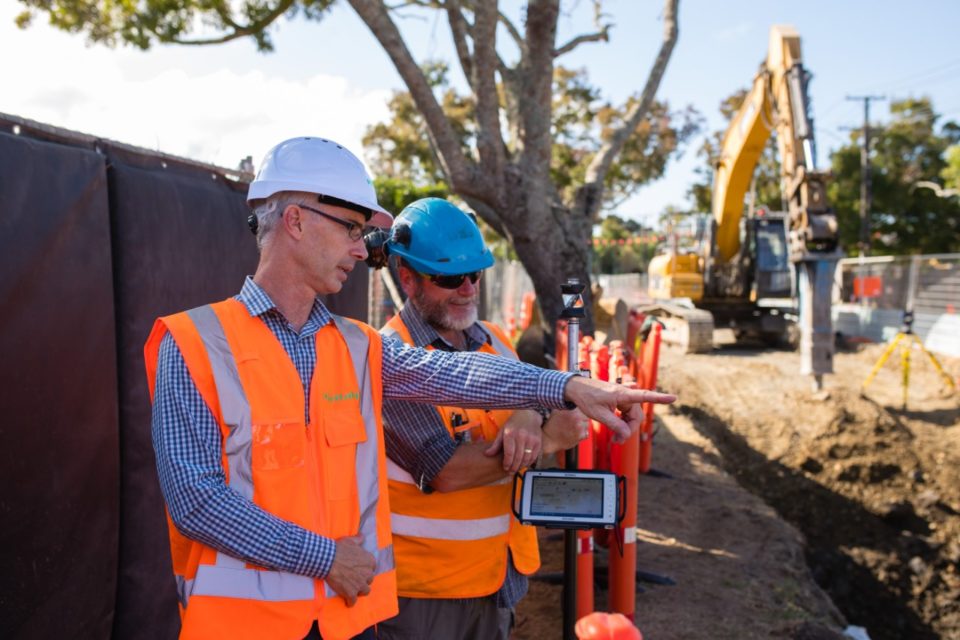Land development alliance Piritahi is delivering build-ready land faster across Auckland by bringing people together in new ways, with better communication and clearer results.
Owairaka’s stormwater management project is an example of how the development alliance’s ground-breaking approach has been changing business as usual for the better.
Owairaka is a neighbourhood in central Auckland with great schools, public amenities and an abundance of parks and green spaces.
Land development alliance Piritahi is currently undertaking work in this neighbourhood to support the delivery of more affordable market homes and better-quality state homes to the community.
However, for the development to be successful, significant upgrades to underground infrastructure are required.
“Owairaka has a combined stormwater and wastewater system built in the 1940s, and with the current plan to increase homes from 190 to 1050, that’s a five times increase in demand on water and wastewater, plus increased stormwater runoff that needs to be managed,” says Piritahi’s Infrastructure Design manager, Ben Chester.
“We’re diverting the stormwater out of the wastewater system, constructing a modern stormwater system and making the wastewater pipes smaller, progressively going through both the Kainga Ora land and private sites, and undertaking a rigorous procedure to make sure that separation is happening.”
Formed to speed up the supply of build-ready land across Auckland, Piritahi is made up of six companies specialising in design, engineering and construction, working together to lay the groundwork for neighbourhoods by designing and constructing new or upgraded infrastructure, parks and public spaces.
They work for one client, Kainga Ora, who is also a member of the alliance.
Meaning “coming together as one”, Piritahi’s alliance model lets member companies bring their expertise and resources to the table to identify and solve problems, share risk and rigorously control budgets.
“You’re bringing together hundreds of years of experience,” says Ben.
“It’s a really good mix of large project experience, land development experience, and construction expertise which when combined, supports excellent outcomes.”
This commitment to collaboration doesn’t stop within Piritahi. As part of the Owairaka stormwater project, they’ve built close relationships and established clear communication channels with key people from council-controlled organisations like Watercare and Healthy Waters.
“Working closely together has made it a lot easier to speak in person, discuss projects and get advice or have a smoother response from other teams,” says Ben.
“It also enables innovation, better Safety in Design, materials selection, constructability and maintenance outcomes. It’s breaking down those barriers, clarifying workloads and making sure that the right people are having the right conversations and getting on with it.
“We call it untying the knots. We’re gaining the trust of the council and building really good relationships, and maintaining that trust through quality assurance and deliverables, and it’s only getting better as we go.”
This close collaboration has helped to ensure that Piritahi is able to provide future-proofed solutions resulting in the best outcomes possible for the community. This ability to take a ‘wide lense’ view of people, place and environment is something that Ben has noticed is motivating his team, especially those who are new to the industry.
“There’s that social and environmental benefit where we can see some real noticeable improvements. When I talk to new graduates who have joined the team, they’ll talk about how they like the design variety, but also about the social impact, and that seems to have more importance for people coming into the industry than what it used to.
“It’s not just a job, it’s about tangible outcomes. It’s not just social housing, it’s market and more affordable housing too because they’re living that.”
The environmental impact of this work is something that’s particularly critical for the Owairaka area. With the current combined stormwater and wastewater system, when it rains it can result in overflows involving raw effluent discharging into the local environment including Te Auaunga (Oakley Creek).
The $30 million stormwater project will reduce flooding and as Ben says, “when we’re finished here the stormwater will go where it needs to and we’ll see a massive reduction in overflows into the creek.”
In addition to the wastewater improvements, the Owairaka stormwater project includes rain gardens and gross pollutant traps to intercept hydrocarbons, dissolved metals, brake lining pollution and bigger pieces of rubbish, like plastic bags.
“This will prevent those contaminants from entering Te Auaunga, and ultimately the Waitemata Harbour,” says Ben.
As you can imagine with a major infrastructure project such as this, making sure locals are onboard and are being effectively communicated with is of vital importance.
“Kainga Ora and Piritahi have a community stakeholder liaison team and since the beginning of last year we’ve been carefully planning a methodology that will work best for the community in terms of noise, vibration and timing,” explains Ben.
“We’ve met with the households most affected, we send out regular updates about what we’re doing, there’s an info cube that allows the community to come and ask questions, and we have a clear process to assist with any concerns they may have.”


Parting words from Jeremy Sole- a final column